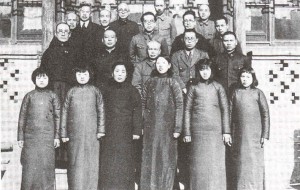As part of its efforts to woo minority populations before and during the Second World War, Japan took a keen interest in Inner Mongolia’s Muslim population, writes JAMES BOYD.
The semi-official Japanese humanitarian organisation, Zenrin kyōkai (Good Neighbour Association), was established in 1933 to provide medical assistance and educational opportunities to the Mongols and Hui (Han Chinese Muslims) on the fringe of the Chinese Republic. The organisation’s initial focus was on the Mongol population north of the Great Wall.
As well as providing medical assistance and educational opportunities, Zenrin kyōkai established a research section, the Northwest Research Institute (NRI), to determine how the organisation could better aid the Mongol population and disseminate information back in Japan to promote its operations in Inner Mongolia.
Following the Japanese military occupation of much of Inner Mongolia’s Suiyuan and Chahar provinces after the outbreak of the Sino-Japanese War in July 1937, Zenrin kyōkai expanded it activities to include the region’s Muslim population. These activities were almost the same as those provided to the Mongol population—providing medical assistance and educational opportunities through travelling clinics or by building clinics in larger towns.
Although the Muslim population was relatively small—perhaps no more than a few hundred thousand—Zenrin kyōkai’s efforts to court them suggest the Japanese authorities saw Muslims as being distinct from the Mongols.
In Japan, the association focused on disseminating scholarship and, in June 1938, established the Institute of Islamic Studies in Tokyo to research Muslim peoples and their faith. The institute published academic works, organised public conferences and produced film documentaries and radio talks. A full run of the institute’s journal, Kaikyōken (Muslim World), has been published as a photographic reproduction, providing an important resource on the institute’s activities.1
Focus on Muslim women
Zenrin kyōkai’s focus on Inner Mongolia’s Muslim population appears to have differed slightly from its focus on the Mongol population. In 1941 and 1942, for example, Zenrin kyōkai held a series of conferences that brought together Muslim women. However, there is little information about the purpose of these conferences or their achievements.

Zenrin kyōkai hosted at least one visit, in 1943, by a group of local Muslim women, to Japan that attracted some interest from the Japanese media. It also established the Zenrin Muslim Girls’ School to promote the education of Muslim women. Although the number of students was quite small, the school’s establishment suggests Zenrin kyōkai saw a benefit to Japan in promoting the education of girls in Inner Mongolia. The NRI subsequently employed some the school’s graduates as clerks.
Established in early 1944, the NRI brought together researchers from Zenrin kyōkai and other Japanese research bodies at a facility in Kalgan, the capital of the Mongolian Federated Autonomous Government.
Headed by the noted anthropologist, Kinji Imanishi (1902–92), the facility numbered among its staff academics who went on to postwar prominence, including anthropologist Tadao Umesao (1920–2010), who was among the founders and the director-general of National Museum of Ethnology in Osaka, and historians Akira Fujieda (1911–98) and Isono Fujiko (1918–2008).
Little research has been done on this institute, which worked closely with Zenrin kyōkai’s Institute of Islamic Studies and the Ethnological Research Institute (ERI), established by the Ministry of Education in Tokyo in 1943. Research by the ERI was intended to contribute to the Japanese government’s wartime policies to handle ethnic groups in its overseas territories.
Winning hearts and minds
Researchers based in Tokyo, in cooperation with the NRI, worked extensively in and around Inner Mongolia throughout 1943–44 to formulate policies to woo ethnic groups living in Inner Mongolia. The apparent purpose of the research was to survey the needs of the local population, and conditions in Inner Mongolia in general, with the aim of using Zenrin kyōkai to help raise living standards. It seems likely the surveys were part of an effort by Japanese authorities to win the hearts and minds of local Muslims.
While there has been research on Japan’s perceptions of and relations with Islam prior to 1945, particularly through the work of Selçuk Esenbel and Cemil Ayden, more remains to be done on many aspects of the relationship—including the operations of Zenrin kyōkai—to produce a fuller picture of Japanese activities in the region in the 1930s and 1940s.
Reference
Kaikyōken Kōkyūjo, Gekkan Kaikyōken, Tokyo (July 1938–April 1944), reprinted Tokyo: Biburio, 1986.
Main photo:
From a 1941 book: an example of the type of photo taken of Mongol children and animals, which the Japanese saw as representative of Mongolia.

